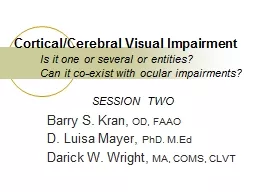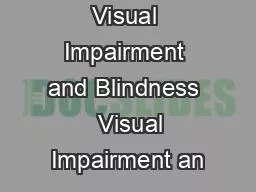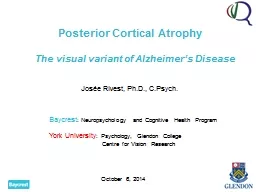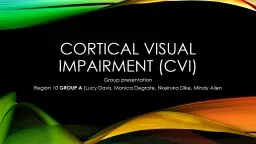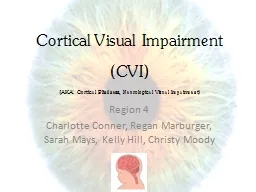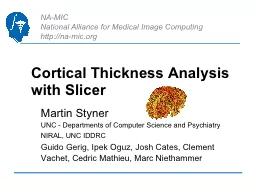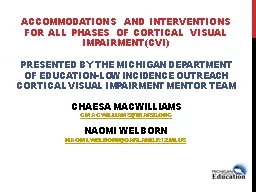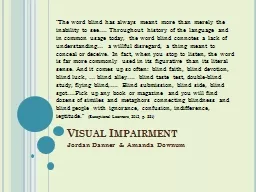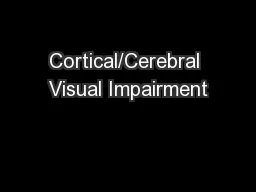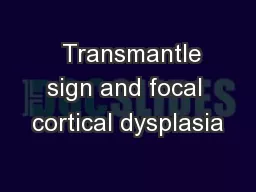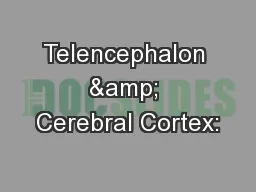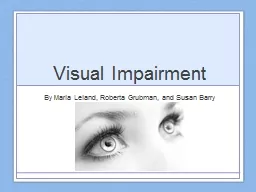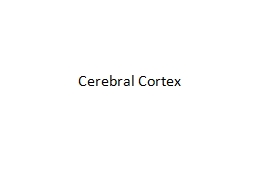PPT-Cortical/Cerebral Visual Impairment
Author : debby-jeon | Published Date : 2016-03-10
Is it one or several or entities Can it coexist with ocular impairments SESSION TWO Barry S Kran OD FAAO D Luisa Mayer PhD MEd Darick W Wright MA COMS CLVT
Presentation Embed Code
Download Presentation
Download Presentation The PPT/PDF document "Cortical/Cerebral Visual Impairment" is the property of its rightful owner. Permission is granted to download and print the materials on this website for personal, non-commercial use only, and to display it on your personal computer provided you do not modify the materials and that you retain all copyright notices contained in the materials. By downloading content from our website, you accept the terms of this agreement.
Cortical/Cerebral Visual Impairment: Transcript
Is it one or several or entities Can it coexist with ocular impairments SESSION TWO Barry S Kran OD FAAO D Luisa Mayer PhD MEd Darick W Wright MA COMS CLVT. Email christinecansimagfr Although cerebral palsy CP is the most common cause of motor de64257ciency in young children it occurs in only 2 to 3 per 1000 live births In order to monitor prevalence rates especially within subgroups birthweight clinica brPage 1br Visual Impairment and Blindness 2010 brPage 2br Visual Impairment and Blindness 2010 brPage 3br brPage 4br brPage 5br Josée. . Rivest, Ph.D., . C.Psych. .. Baycrest. : . Neuropsychology . and Cognitive . Health Program. York University. : Psychology, Glendon College. Centre for Vision Research. October 6, 2014. Group presentation. Region 10 . GROUP A. . (Lucy Davis. , . Monica Degrate. , . Nkeiruka Dike. , . Mindy Allen. What Is cvi?. Cortical . Visual Impairment (CVI) is an acquired bilateral visual acuity loss caused by brain damage to the occipital lobes and/or damage to the posterior (. (CVI). (AKA: Cortical Blindness, Neurological Visual Impairment). Region 4. Charlotte Conner, Regan Marburger, Sarah Mays, Kelly Hill, Christy Moody. What is CVI??. Most commonly seen in children. Not caused by eye condition. Martin Styner. UNC - Departments of Computer Science and Psychiatry. NIRAL, UNC IDDRC. Guido . Gerig. , . Ipek. . Oguz. , Josh Cates, . Clement . Vachet. , Cedric Mathieu, Marc . Niethammer. Motivation Neuroimaging. Chaesa. . macwilliams. . . cmacwilliams@tbaisd.org. . . Naomi Welborn . naomi.Welborn@oakland.k12.mi.us. Accommodations and interventions for all phases of Cortical visual impairment(CVI). Jordan Danner & Amanda . Downum. . “The word blind has always meant more than merely the inability to see…. Throughout history of the language and in common usage today, the word blind connotes a lack of understanding… a willful disregard, a thing meant to conceal or deceive. In fact, when you stop to listen, the word is far more commonly used in its figurative than its literal sense. And it comes up so often: blind faith, blind devotion, blind luck, … blind alley…. blind taste test, double-blind study, flying blind,…. Blind submission, blind side, blind spot….Pick up any book or magazine and you will find dozens of similes and metaphors connecting blindness and blind people with ignorance, confusion, indifference, . Is it one or several or entities? Can it co - exist with ocular impairments? SESSION ONE Barry S. Kran , OD, FAAO Darick W. Wright, MA, COMS, CLVT D. Luisa Mayer, PhD. MEd Webinar Objectives 1. A. . Luppi. , . 1. G. N. . Simao. , . 2 . L. . Neder, . 2 . J. E. H. . Pittella. , . 3. T. Velasco, . 4. C.G. . Carlotti. Jr., . 4. H.R. Machado, . 3. A.C. Sakamoto, . 1. A.C. Santos. Presentation number. Gross Anatomy. S. J. Potashner. sjp9713@neuron.uchc.edu. Cerebrum or Telencephalon. Claustrum. Cerebral cortex. Cerebral white. matter. Basal ganglia. video. The Cerebral Cortex - Lobes. The Cerebral Cortex – Cell Layers. Grubman, and Susan Barry. What defines visual impairment?. Visual Impairment Including Blindness: a visual impairment, that even with correction, adversely affects a child’s educational performance. This term includes both partial sight and blindness. (. CONTENTS. Introduction. Definition of hearing impairment. Classification of hearing impairment. Prevalence of hearing impairment. Measurement. Causes and treatment. Definition of visual impairment. Classification of visual impairment. Primary Visual Cortex. Primary Auditory Cortex. Primary . Somatosensory. Cortex. Primary Motor Cortex. Associative Cortex. Primary Sensory Cortex. Primary Motor Cortex. Situated adjacent to each Primary cortex.
Download Document
Here is the link to download the presentation.
"Cortical/Cerebral Visual Impairment"The content belongs to its owner. You may download and print it for personal use, without modification, and keep all copyright notices. By downloading, you agree to these terms.
Related Documents

